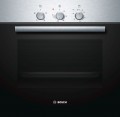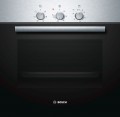Capacity
The working capacity of the oven. The amount of food that can be cooked in the device and the amount of space required for embedding depends on this parameter.
A capacity of about 50 – 60 litres is considered quite sufficient for a family of 2 – 3 people. It is the capacity that most modern built-in ovens have. However, there are other options — modest models of 20 – 30 litres, similar in capacity to microwave ovens,
large in capacity for home baking and large cabinets of 100 litres or more, designed more for cafes and restaurants than for home use.
Number of modes
The number of cooking modes provided in the design of the oven. In this case, the cooking mode means the general opertaion mode — for example, “heating”, “heating + convection”, etc. Accordingly, this indicator strongly depends on additional equipment (see "Features"). However, even in similar models, the number of modes may be different. In general, the
more cooking modes, the more cooking options, the easier it will be to choose the optimal mode for a specific situation.
Energy class
This indicator characterizes how economically the oven consumes electricity. Initially, classes were marked in Latin letters from
A(highest) and further down as they went down. Later improved classes
A +,
A ++, etc. appeared (the more pluses, the better). More energy-efficient models are more expensive but can pay for themselves in the process of use, especially if you have to cook often and in large quantities.
Dimensions (HxWxD)
In the case of ovens, the dimensions determine not only the sizes, but also the conditional form factor and the possibility of installing models. Dividing by height, the devices can be
compact(low) for installation in hanging cabinets and
full-sized — classic ovens for installation under the countertop. As for the width, in addition to
standard models of 60 cm, there are
narrow (45 cm) and
wide (90 cm) models to interact with similar wide hobs.
Country of origin
The country in which, according to the manufacturer, this or that model is manufactured. Even though most of the capacities are concentrated in
China, European factories for the production of household appliances have not disappeared. And certain models can be produced on them. In general, such a division into a Chinese or European factory (
Germany,
Italy,
Poland,
Turkey) should not particularly affect the quality of products, but still the stereotype of a reliable European assembly is present in us. However, it is possible that the model may have a country of manufacture, for example, Poland, and in the store under the same article, you will meet China.

